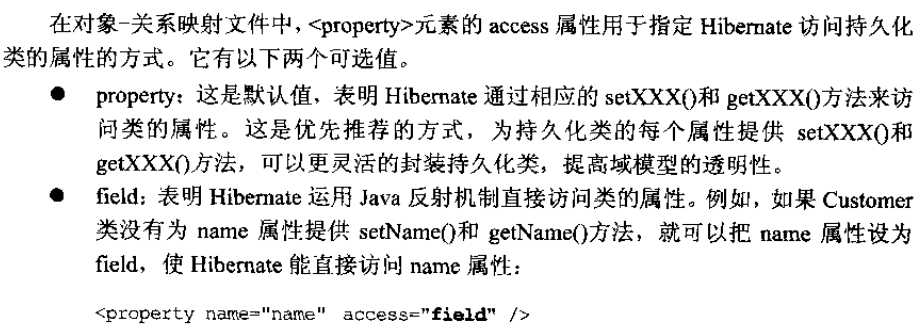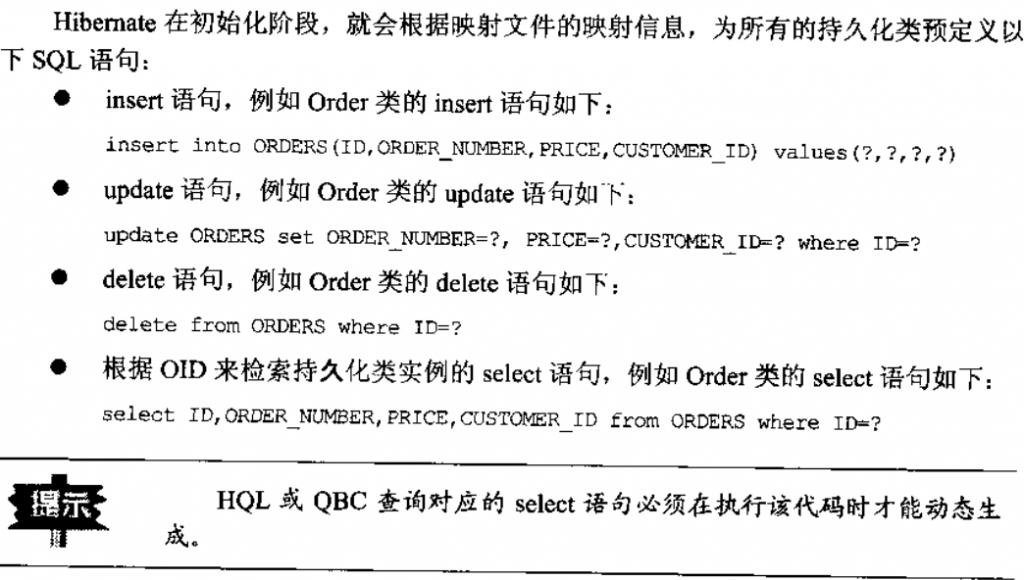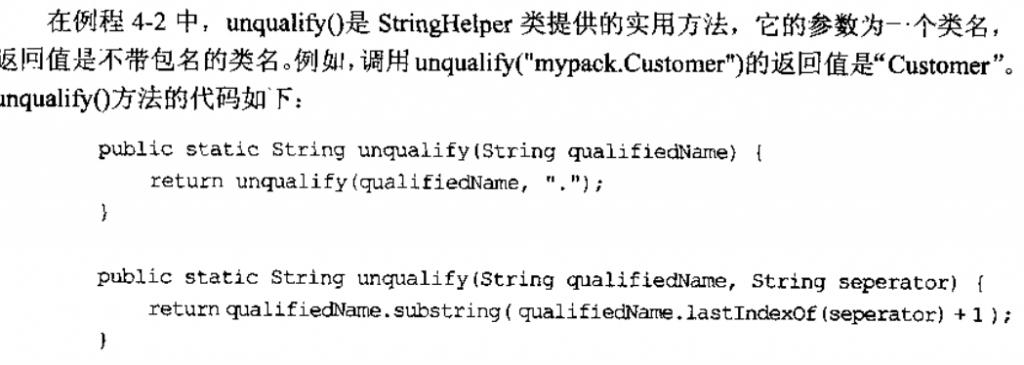1、持久化类的属性和访问方法
(1)持久化类简介

在Hibernate中持久化类的访问方法有两个调用者,一个是Java应用程序,一个是Hibernate。值得注意的是,Java应用程序不能访问持久化类的private类型的getXXX()、setXXX(),而Hibernate没有这样的限制。
(2)基本类型属性和包装类型属性
Java有8种基本类型:byte,short,char,int,long,float,double,boolean;与之对应的Java提供了8种包装类型:Byte,Short,Character,Integer,Long,Float,Double,Boolean。基本类型与包装类型之间可以如下简单转换:
- double prD=1;
- //把double基本类型转换成Double包装类型
- Double wrD=new Double(prD);
- //把Double包装类型转换成double基本类型
- prD=wrD.doubleValue();
Hibernate两种类型都是支持的。
(3)在持久化类的访问方法中加入程序逻辑
(a)在Customer类的getName()和setName()方法中加入程序逻辑
假如在Customer类中有firstname属性和lastname属性,但是没有name属性,而数据库CUSTOMERS表中只有NAME字段。当Hibernate从数据库中取得了CUSTOMERS表的NAME字段值后,会调用setName()方法,此时应该让Hibernate通过setName()方法来自动设置firstname属性和lastname。故要在setName()方法中加入额外的程序逻辑。
- public String getName(){
- return firstname+ " "+lastname;
- }
- public void setName(String name){
- StringTokenizer t=new StringTokenizer(name);
- firstname=t.nextToken();
- lastname=t.nextToken();
- }
在映射文件中此时直接映射name即可,无需映射firstname等。
- <property name="name" column="NAME">
尽管在Customer类中没有定义name属性,由于Hibernate并不会直接访问name属性,而是通过getName()和setName()方法。只要在Customer.hbm.xml文件中映射了name属性,HQL语句就能访问:
- Query query=seesion.createQuery("from Customer as c where c.name='Tom'");
但是如果把Customer.hbm.xml文件中name属性配置为:
- <property name="name" column="NAME" access="field">
程序会直接去访问Customer实例中的name属性,就会出现异常。

(b)在Customer类的setOrders()方法中加入程序逻辑
假定Customer类中有一个avgPrice属性,表示订单的平均价格,取值为它所关联Order对象的price的平均值。在CUSTOMERS表中没有AVG_PRICE字段。可以如下操作:
- public Double getAvgPrice(){
- return this.avgPrice;
- }
- private void setAvgPrice( Double avgPrice ){
- this.avgPrice = avgPrice;
- }
- public Double getTotalPrice(){
- return this.totalPrice;
- }
- private void setTotalPrice( Double totalPrice ){
- this.totalPrice = totalPrice;
- }
- public void setOrders( Set orders ){
- this.orders = orders;
- calculatePrice();
- }
- public Set getOrders(){
- return orders;
- }//定义为一个Set
- private void calculatePrice(){
- double avgPrice = 0.0;
- double totalPrice = 0.0;
- int count=0;
- /迭代计算orders里面所有price
- if ( getOrders() != null ){
- Iterator iter = getOrders().iterator();
- while( iter.hasNext() ){
- double orderPrice = ((Order)iter.next()).getPrice();
- totalPrice += orderPrice;
- count++;
- }
- // Set the price for the order from the calcualted value
- avgPrice=totalPrice/count;
- setAvgPrice( new Double(avgPrice) );
- }
- }
在Customer.hbm.xml文件不用映射avgPrice,因为Hibernate不会直接访问avgPrice属性,也不会调用getavgPrice()和setavgPrice().
(c)在Customer类的setSex()方法中加入数据验证逻辑
在持久化类的访问方法中,还可以加入数据验证逻辑。
- public char getSex(){
- return this.sex;
- }
- public void setSex(char sex){
- if(sex!='F' && sex!='M'){
- throw new IllegalArgumentException("Invalid Sex");
- }
- this.sex =sex ;
- }
(4)设置派生属性
持久化类并非所有属性都直接和表的字段匹配,持久化类的有些属性是可以在运行的时候得出的,这些称作派生属性。正如之前的avgPrice属性,该方案包括两个步骤:
- 在映射文件中不映射avgPrice属性
- 在Customer类的setOrders()方法中加入程序逻辑,自动为avgPrice属性赋值。
除了这种方法来设置派生属性,还可以如下解决:
利用<property>元素的formula属性。formula属性用来设置一个SQL表达式,Hibernate将根据它来计算派生属性的值。以Customer类的totalPrice属性为例:
- <property name="totalPrice" formula="(select sum(o.PRICE) from ORDERS o where o.CUSTOMER_ID=ID)"/>
在Hibernate从数据库中查询Customer对象时,若查询totalPrice,即:
- select totalPrice from CUSTOMERS;
使用formula属性后,上面的查询语句就会自动地被替代成:
- select (select sum(o.PRICE) from ORDERS o where o.CUSTOMER_ID=1) from CUSTOMERS;
如果子句的查询结果为空,那么上述的语句就会出现异常。解决方法是:将totalPrice的属性定义为Double包装类型。
(5)控制insert和update语句
Hibernate在初始化阶段,就会根据映射文件的映射信息,为所有的持久化类定义以下的SQL语句。

以上SQL语句中的“?”代表JDBC PreparedStatement中的参数。这些SQL语句都存放在SessionFactory的内置缓存中,当执行Session的save()、update()、delete() 、load()和get()方法的时候,将从缓存中找到对应预定义的SQL语句,再把具体的参数值绑定到该SQL语句中。


#p#
2、创建命名策略

还有一直一种方法是实现Hibernate的org.hibernate.cfg.NamingStrategy接口,对于这个接口Hibernate提供了两种参考实现类:org.hibernate.cfg.defaultNamingStrategy和org.hibernate.cfg.ImprovedNamingStrategy类。
MyNamingStrategy.java
- package mypack;
- import org.hibernate.cfg.ImprovedNamingStrategy;
- import org.hibernate.util.StringHelper;
- public class MyNamingStrategy extends ImprovedNamingStrategy {
- public String classToTableName(String className) {
- return StringHelper.unqualify(className).toUpperCase()+'S';//classname转化成大写字母+S就是对应的表名
- }
- public String propertyToColumnName(String propertyName) {
- return propertyName.toUpperCase();
- }
- public String tableName(String tableName) {
- return tableName;
- }
- public String columnName(String columnName) {
- return columnName;
- }
- public String propertyToTableName(String className, String propertyName) {
- return classToTableName(className) + '_' +
- propertyToColumnName(propertyName);
- }
- }



使用命名策略后可以更好的将数据库中表名、列名对象化成类中的对象。

#p#
3、实例
本节的代码下载地址:http://down.51cto.com/data/326754
主要的BusinessService.java
- package mypack;
- import org.hibernate.*;
- import org.hibernate.cfg.Configuration;
- import java.util.*;
- public class BusinessService{
- public static SessionFactory sessionFactory;
- static{
- try{
- Configuration config = new Configuration()
- .setNamingStrategy( new MyNamingStrategy() )
- .configure(); //加载hibernate.cfg.xml文件中配置的信息
- sessionFactory = config.buildSessionFactory();
- }catch(RuntimeException e){e.printStackTrace();throw e;}
- }
- public Customer loadCustomer(long customer_id){
- Session session = sessionFactory.openSession();
- Transaction tx = null;
- try {
- tx = session.beginTransaction();
- Customer customer=(Customer)session.get(Customer.class,new Long(customer_id));
- tx.commit();
- return customer;
- }catch (RuntimeException e) {
- if (tx != null) {
- tx.rollback();
- }
- throw e;
- } finally {
- session.close();
- }
- }
- public void saveCustomer(Customer customer){
- Session session = sessionFactory.openSession();
- Transaction tx = null;
- try {
- tx = session.beginTransaction();
- session.save(customer);
- tx.commit();
- }catch (RuntimeException e) {
- if (tx != null) {
- tx.rollback();
- }
- throw e;
- } finally {
- session.close();
- }
- }
- public void loadAndUpdateCustomer(long customerId) {
- Session session = sessionFactory.openSession();
- Transaction tx = null;
- try {
- tx = session.beginTransaction();
- Customer customer=(Customer)session.get(Customer.class,new Long(customerId));
- customer.setDescription("A lovely customer!");
- tx.commit();
- }catch (RuntimeException e) {
- if (tx != null) {
- tx.rollback();
- }
- throw e;
- } finally {
- session.close();
- }
- }
- public void updateCustomer(Customer customer){
- Session session = sessionFactory.openSession();
- Transaction tx = null;
- try {
- tx = session.beginTransaction();
- session.update(customer);
- tx.commit();
- }catch (RuntimeException e) {
- if (tx != null) {
- tx.rollback();
- }
- throw e;
- } finally {
- session.close();
- }
- }
- public void saveDictionary(Dictionary dictionary) {
- Session session = sessionFactory.openSession();
- Transaction tx = null;
- try {
- tx = session.beginTransaction();
- session.save(dictionary);
- tx.commit();
- }catch (RuntimeException e) {
- if (tx != null) {
- tx.rollback();
- }
- throw e;
- } finally {
- session.close();
- }
- }
- public void updateDictionary(Dictionary dictionary){
- Session session = sessionFactory.openSession();
- Transaction tx = null;
- try {
- tx = session.beginTransaction();
- session.update(dictionary);
- tx.commit();
- }catch (RuntimeException e) {
- if (tx != null) {
- tx.rollback();
- }
- throw e;
- } finally {
- session.close();
- }
- }
- public Dictionary loadDictionary(long dictionary_id) {
- Session session = sessionFactory.openSession();
- Transaction tx = null;
- try {
- tx = session.beginTransaction();
- Dictionary dictionary=(Dictionary)session.get(Dictionary.class,new Long(dictionary_id));
- tx.commit();
- return dictionary;
- }catch (RuntimeException e) {
- if (tx != null) {
- tx.rollback();
- }
- throw e;
- } finally {
- session.close();
- }
- }
- public void printCustomer(Customer customer){
- System.out.println("name:"+customer.getName());
- System.out.println("sex:"+customer.getSex());
- System.out.println("description:"+customer.getDescription());
- System.out.println("avgPrice:"+customer.getAvgPrice());
- System.out.println("totalPrice:"+customer.getTotalPrice());
- }
- public void printDictionary(Dictionary dictionary){
- System.out.println("type:"+dictionary.getType());
- System.out.println("key:"+dictionary.getKey());
- System.out.println("value:"+dictionary.getValue());
- }
- public void test(){
- Customer customer=new Customer("Laosan","Zhang",'M',new HashSet(),"A good citizen!");
- Order order1=new Order("Order001",new Double(100),customer);
- Order order2=new Order("Order002",new Double(200),customer);
- customer.getOrders().add(order1);
- customer.getOrders().add(order2);
- saveCustomer(customer);
- customer=new Customer("Laowu","Wang",'M',new HashSet(),null);
- saveCustomer(customer);
- customer=loadCustomer(1);
- printCustomer(customer);
- customer.setDescription("An honest customer!");
- updateCustomer(customer);
- loadAndUpdateCustomer(1);
- Dictionary dictionary=new Dictionary("SEX","M","MALE");
- saveDictionary(dictionary);
- dictionary=loadDictionary(1);
- dictionary.setValue("MAN");
- updateDictionary(dictionary);
- dictionary=loadDictionary(1);
- printDictionary(dictionary);
- }
- public static void main(String args[]) {
- new BusinessService().test();
- sessionFactory.close();
- }
- }
原文链接:http://blog.csdn.net/yu422560654/article/details/7047661
【编辑推荐】

























